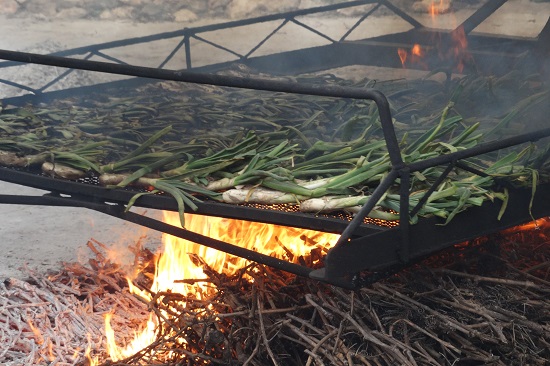Onions on fire: the internationalisation of ‘calçots’
The 'calçot' - a type of long white spring onion - is a traditional food in Catalonia, a delicacy from the winter months, eaten with its own sauce. In Valls, the cradle of 'calçots', local and international chefs meet to create new dishes with this ingredient. The 'calçots' season, which starts in November and lasts until April, officially begins during the last weekend of January, when Valls celebrates its ‘Gran Festa de la Calçotada’. This party, which attracts thousands of people and media from around the world, is one of the most important Catalan gastronomic events. But why is Valls the capital of 'calçotades'? What is the correct way to cook 'calçots' and its sauce like a professional, and why is this event becoming so international?

Valls (ACN)-. The ‘Gran Festa de la Calçota de Valls’ - one of the most important gastronomic events in Catalonia - took place at the end of January. With more than 40,000 visitors every year, it officially marks the start of the 'calçots' season. Every year it attracts media and tourists from Catalonia, Spain and around the world who want to participate in the different activities which take place, such as the 'calçots' eating. But why is Valls the capital of 'calçotades'? What is the correct way to cook 'calçots' and its sauce like a professional, and why is this event becoming so international?
Valls, the cradle of 'calçots'
A 'calçot' is a type of long white spring onion cultivated in a special way. These onions are called 'calçots' because while they are growing the farmer has to 'calçar-les' -wrap the onions with soil- many times. This process gives 'calçots' their characteristic long shape.
This agricultural technique was discovered at the end of the 19th century by a Valls farmer, who is said to have invented the sauce that accompanies 'calçots' and the way to cook them too. Since then, eating 'calçots' has become one of the main Catalan gastronomic - and social - traditions of the year, with families and friends gathering together every year to celebrate a ‘calçotada’, the event where 'calçots' are cooked and eaten.
How to cook and eat 'calçots' correctly?
First of all, 'calçots' must be harvested just before they are cooked. Secondly, we need to prepare 'calçots' for the fire: by cutting their leaves in order to make them shorter, and cutting a little part of the root. The next step is to spread out the 'calçots' on a grill, leaving space between each onion so that the flame can pass through it. Then 'calçots' are ready to be cooked.
Next comes the moment to light the fire, preferably with firewood and branches. Then, we just have to put the grill over the flames. While 'calçots' are being cooked it is necessary to move the grill and spin them twice, and we have to do it when we see that the onions lose some water. 'Calçots' are ready when their exterior becomes black but their end is soft. The last step is to wrap 'calçots' in newspaper to keep them hot until we eat them.
The way to eat these onions is very special. We advise you to put on a 'pitet' - something like a bib - in order to prevent you from getting too dirty. You have to hold a 'calçot' by the leaf with one hand and stretch out the peel downwards with the other hand. Then, you dip the end of the 'calçot' in a special sauce, raise it over your head and enjoy. A normal portion is between fifteen and twenty calçots per person.
'Calçots' sauce
'Calçots' should be eaten with a sauce that is similar to 'romesco', made with different types of vegetables. The traditional recipe is easy and the quantity of ingredients depends on the number of people that are going to eat. If we want to do the sauce, we should start grinding toasted almonds and hazelnuts, grilled garlic bulbs, tomatoes and, finally, parsley. While we are mixing all these ingredients we add the olive oil. Finally, we add to the mixture a half glass of vinegar, one dry or sweet red pepper, and salt. The sauce can be modified to be spicier or thicker.
Why is it an international phenomenon?
The 'calçots' season starts in November and lasts until April, but the months of February and March are when most people enjoy this dish. The ‘Gran Festa de la Calçotada de Valls’ is the event that marks on the calendar the official beginning of the 'calçots' season as it attracts more than 40,000 people per year. This huge party includes a contest where the winner is the competitor able to eat the most 'calçots'.
The international media started to be interested in this event some years ago, and now the Calçotada of Valls is known around the world. Each year, media from many countries such as Japan and Germany come to Valls with the purpose of covering this tradition. International tourists also attend the event. In fact, there are some travel agencies that offer trips to Valls to let people taste this food and live this experience.